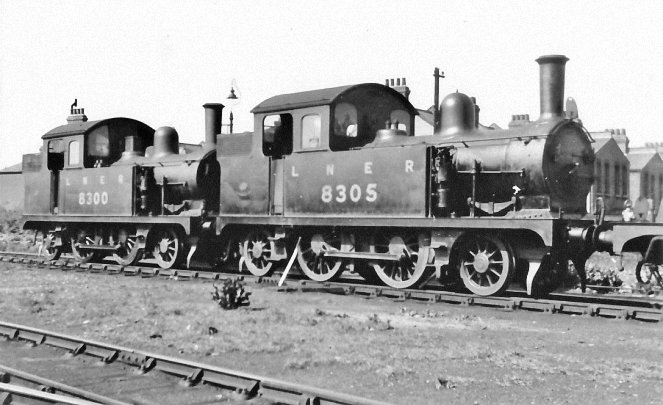Y65 Class 2-4-2T 1909-1910
LNER Class F-7
1300-1311
 GERS Collection 7032/48
GERS Collection 7032/48
The first two engines of the Y65 class appeared in 1909 under S.D. Holden. Intended for light branch duties to replace the E22 class 0-6-0Ts (q.v.), in general layout they were a scaled-down version of the M15 class 2-4-2T (q.v.) with smaller driving wheels 4-ft 10-ins. in diameter and radial axles at either end. The motion appears to have been the same as that used on the 0-6-0Ts, but otherwise they were non-standard, the boiler in particularly being of smaller diameter than the other standard types. They were the first GER tank engines to have the ‘second generation’ details first seen on the Claud Hamilton 4-4-0s of 1900, having built-up rimmed chimneys with a polished cap in place of the customary plain stovepipe. Incidentally, these chimneys were tapered, whereas on all other classes they were parallel-sided. However, the most noticeable feature was the large side-window cabs that seemed out of proportion to the rest of the locomotives. As a result, they were quickly dubbed “Crystal Palace Tanks” or “Glasshouse Gobblers”, and even “Tomato Houses” when three later migrated to Scotland. The first two engines were 1300 and 1301, and they were quickly followed by another ten numbered 1302-1311. No. 1300 is seen in this official portrait, and the later ten engines differed in that the cab weatherboard windows were of similar shape to those at the sides.
 W. Potter/GERSHC 7019/138
W. Potter/GERSHC 7019/138
In their early years the Y65 2-4-2Ts wandered around a number of GER branch lines, but the crews preferred the E22 0-6-0Ts that they were intended to replace. This is perhaps hardly surprising, as the 0-6-0Ts had a higher tractive effort, larger boilers and even though when running as 2-4-0Ts, their adhesive weight was only a few hundredweight less. However, they found their niche during the First World War when several munitions factories were opened along the route of the Churchbury Loop between Lower Edmonton and Cheshunt. Several temporary halts were opened and served by push-pull or ‘motor’ trains operated by the Y65s. The GER had begun push-pull operation with these engines before 1914, having adopted a similar compressed air-operated control system as the London Brighton and South Coast Railway, and which became the Southern Railway standard. To provide ample compressed air the motor-fitted Y65s had a second Westinghouse pump on the front of the nearside tank, as shown in the photograph. With the inauguration of the ‘Jazz’ suburban services a push-pull service was operated for many years between Seven Sisters and Palace Gates, and the photograph shows No. 8304 (ex-1304) departing from Noel Park & Wood Green station in the 1930s. Note that although a tail lamp is carried at what is now the rear of the train, the headcode disc remains in position.
 V. R. Webster 1017/GERSHC 7005/093
V. R. Webster 1017/GERSHC 7005/093
Under the LNER the Y65s became class F-7 and this photograph shows Nos. 8300 and 8305 in the 1930s at Palace Gates. No. 8300 has the larger cab weatherboard windows and still has Ramsbottom safety valves, whereas 8307 has the neater windows and pop safety valves mounted on the original seating. Both have acquired cast rimmed chimneys. No. 8300 was never push-pull fitted, but with typical GER frugality, the connections were only fitted at the rear of the engines, so from this side it is impossible to tell if 8305 is equipped at the date of the photograph. Generally, three engines were needed to run the Palace Gates motor trains, and the gear was moved from engine to engine when called into Stratford for repair.
 GERS Collection 7026/355
GERS Collection 7026/355
Shortly after the Grouping, No. 8307 was selected to run the Verney Junction to Quainton Road push-pull service on the former Great Central line. The ancient old 2-4-0 tank engine that had been operating the service visited Stratford in 1924 so that its equally-ancient wire-and-pulley system could be fitted to 8307. The engine, carriage and a trailing van are seen in the photograph at Verney Junction. The first withdrawals of the class took place in 1931, and the last survivors were two of the three that had been sent to Scotland in the 1930s. They were ex-GER numbers 1308 and 1310, later renumbered as 7093 and 7094, but they were withdrawn towards the end of 1948 without acquiring BR numbers.
